
Larinus is a genus of true weevils, comprising about 180 species, mostly in the Palaearctic region with some species introduced to North America. Turkey appears to have a significant diversity of the group, with more than 50 species recorded in the eastern part of the country.
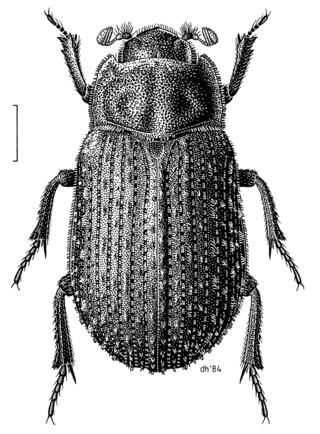
Trox scaber is a beetle of the family Trogidae. The 5 to 8 mm long insect is found worldwide, including in Europe, and lives in bird nests.

Adalia decempunctata, the ten-spotted ladybird or ten-spotted lady beetle, is a carnivorous beetle of the family Coccinellidae.

Lilioceris merdigera is a species of beetle belonging to the family Chrysomelidae, subfamily Criocerinae.
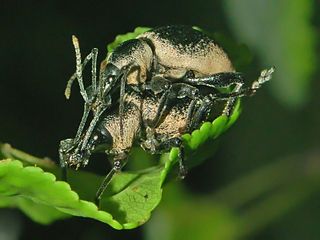
Otiorhynchus vehemens is a species of broad-nosed weevils belonging to the family Curculionidae, subfamily Entiminae.

Eupholus bennetti is a species of beetle belonging to the family Curculionidae.
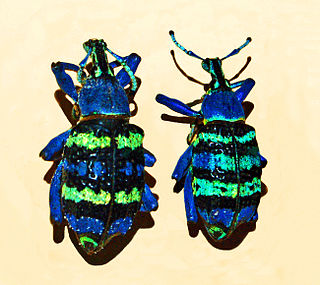
Eupholus magnificus is a species of beetle belonging to the family Curculionidae.

Rhinastus sternicornis is a species of beetles belonging to the family Curculionidae.
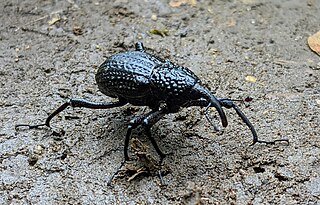
Sipalinus gigas is a species of beetles belonging to the family Curculionidae.

Eupholus petitii is a disputed species of beetle belonging to the family Curculionidae.

Apoderus coryli, the hazel-leaf roller weevil, is a species of leaf-rolling beetles belonging to the family Attelabidae subfamily Attelabinae. Because of the trunk-like elongated head, it is often mistakenly attributed to the weevil family Curculionidae.

Eupholus azureus is a species of beetles belonging to the family Curculionidae.

Sulcophanaeus imperator is a brightly colored species of dung beetle belonging to the family Scarabaeidae. This diurnal, coprophagous beetle is native to south-central South America and generally common. It is paracoprid, meaning that adults dig tunnels into the soil under the food source and move parts of the food source to a nest chamber where the eggs are laid.

Tillus elongatus is a species of beetle in the family of checkered beetles Cleridae. It is found in the Palearctic. The “Holz” in the German common name Holzbuntkäfer indicates that these checkered beetles are found in wood. Although Tillus elongatus can reach up to a size of 1 cm long, the beetle is rarely seen by humans, as it primarily resides hidden in the wood of trees. The colouration of the males differs from that of the females.

Bodiloides ictericus is a species of dung beetle in the family Scarabaeidae, found in the Palearctic. It is one of more than 50 species in the genus Bodiloides.

Larinus turbinatus is a species of true weevil in the family of beetles known as Curculionidae.
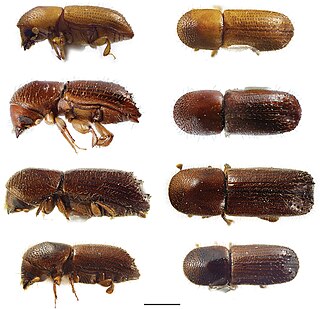
Xyleborus affinis, the sugarcane shot-hole borer, is a species of ambrosia beetle in the family Curculionidae. It is found on all continents with woodlands and is one of the most widespread ambrosia beetles internationally, primarily in areas with humid tropical climates like Florida. Like other ambrosia beetles, Xyleborus affinis is attracted to dead fallen logs in early stages of decay. Due to the presence of X. affinis on moist timber, this species is mistakenly believed to be the cause of tree death. However, there is insufficient evidence to support their presence as a causal factor. Rather, these beetles are believed to target and accelerate the decay process of trees that are already deteriorated and weak.

Larinus sturnus is a species of cylindrical weevils belonging to the family Curculionidae, subfamily Lixinae.

Cryphalus saltuarius - Cryphalus asperatus is a small bark beetle, around 1.8 mm long, that infests mainly spruce trees (Picea), less often other conifers. It has been recorded mainly from northern Europe and is occasionally regarded as a secondary pest. However, it attacks primarily weakened and freshly dead branches of its host trees.

Cryphalus dorsalis is a small bark beetle, 1.60–1.90 mm long and found in southern parts of Asia with a distribution range from India in the west to Java (Indonesia), the Philippines and southern China in the east. Little information is available on its biology, even on its host plants. In a detailed re-description of the species based on light trap material and specimens without host plant records, Johnson et al. (2020) mentioned that fir (Abies) has been cited as a host plant in one publication which recorded it from Hainan Island (China) where Abies does not grow.




















